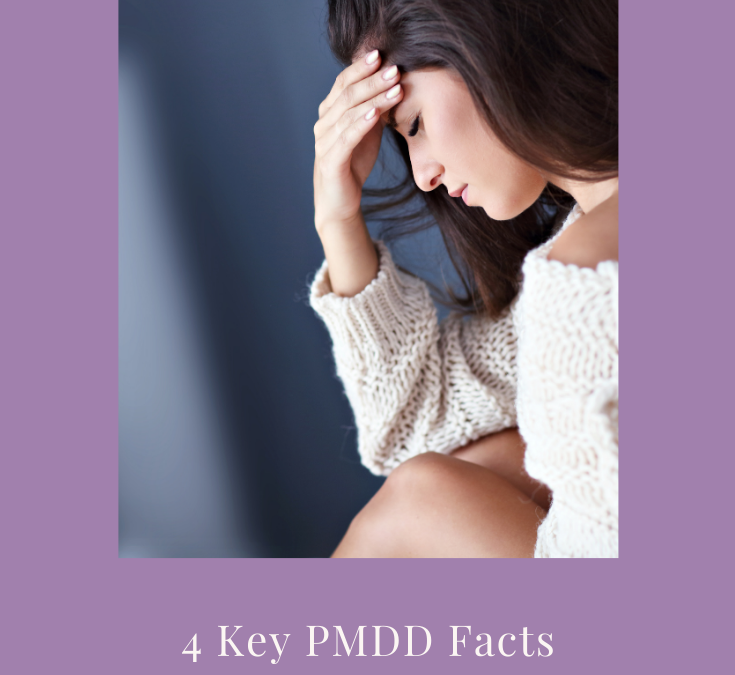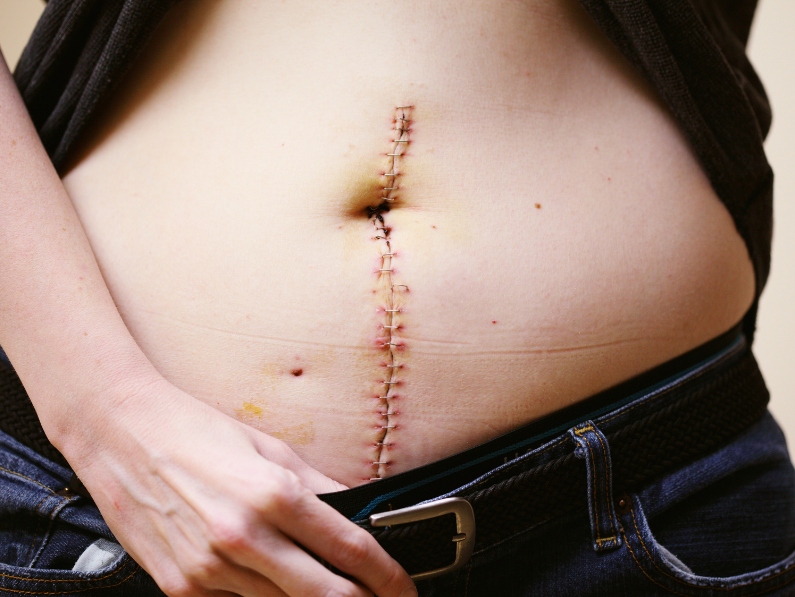PMDD (premenstrual dysphoric disorder), is a chronic health condition that impacts 20 to 40% of menstruators. And, it’s defined by Mayo Clinic as an advanced form of PMS (premenstrual syndrome) that affects mental health and quality of life. Yet, there’s very little awareness or understanding regarding how PMDD affects the health and well-being of those diagnosed with it. So, in this blog post, I want to share four things I’ve learned about PMDD. And, provide general advice and resources on what to do if you believe you have it.
Page Contents
#1. PMDD Symptoms are Similar to PMS
One reason PMDD may be so misunderstood is that it shares a lot of similarities with PMS. Both occur around 10 days before menstruation and contribute to physical, emotional, and mental symptoms. Commonly shared symptoms include muscle aches, lower back pain, pelvic cramping, breast tenderness, bloating, constipation, diarrhea, fatigue, appetite changes, mood swings, anxiety, depression, irritability, acne, inability to focus, forgetfulness, headache, and sleep disturbances.
However, the key differentiator is the intensity in which symptoms are experienced by PMDD patients. For instance, depression and anxiety can be so intense they may withdraw from social interaction, become detached from their daily routines, and feel a general sense of dissatisfaction with their lives. In some instances, the severity of these feelings can lead to suicidal thoughts and extreme behavioral shifts that complicate personal relationships.

#2 PMDD Requires A Proper Diagnosis
Usually, PMS is self-diagnosed and doesn’t need medical intervention to manage symptoms. Whereas, PMDD requires a medical diagnosis and a combination of therapies and lifestyle changes to decrease symptoms.
Since PMDD can’t be diagnosed via a blood test, doctors have to undergo a differential diagnostic process to rule out other underlying conditions. Key factors that are taken into consideration include understanding how long these symptoms have been an issue and when symptoms present themself. Another vital aspect includes symptoms improving a few days after menstruation has started and if these symptoms decrease the overall quality of life. Additionally, a symptom chart can help identify a pattern between when symptoms occur and the menstrual cycle.
Doctors evaluate this information and may diagnose you with PMDD if you’ve had these symptoms for 2 consecutive cycles. Or, symptoms occur a week before menstruation and improve around the third day of your period. Additionally, you must display at least five symptoms that involve one or more of the following: depression, anxiety, extreme mood changes, or increased anger and irritability. Your doctor may discuss various treatment options, including hormonal birth control, anti-depressants, therapy, and alternative medicine.
#3. It can take up to 12 years to get a proper PMDD diagnosis
Lack of awareness about this condition can make getting PMDD diagnosed a challenge. Not understanding the connection between symptoms and your menstrual cycle may cause you to overlook signs. Discussing complications with a doctor that isn’t familiar with PMDD may contribute to misdiagnosis, especially considering that it shares similarities with PMS and mental health disorders such as depression and bipolar disorder. Additionally, if you have a pre-existing mental health disorder, it can increase your PMDD risk and contribute to increased symptom severity.
This is why it’s crucial to track your symptoms alongside your menstrual cycle. So, you and your physician can make a note of any patterns or cyclical symptoms. Consequently moving the diagnostic process forward.

#4. Suicide Rates Are High for those with PMDD
Suicidal ideation and increased thoughts about suicide are relatively common for many PMDD patients. Consequently, 30% of those with PMDD attempt suicide. So, if you find that you’re struggling with suicidal thoughts or have attempted suicide before your period, PMDD could be the root cause. And you should definitely speak with your medical professional.
If you’re currently struggling with suicidal thoughts or struggling with feelings of overwhelm, don’t hesitate to reach out—hotlines like the National Suicide Prevention Hotline provide help and guidance. Scheduling an appointment with your physician and discussing what you’re going through may lead to medical intervention or therapy recommendations.
What to Do if You Suspect PMDD
If you believe that you may have PMDD, you should schedule a dedicated appointment with your doctor to discuss this possibility. Also, begin tracking your symptoms with your menstrual cycle to identify any patterns or cyclical symptoms. You may need to commit to this for several months before you’re able to notice any specific patterns or cyclical behavior. Journaling, tracking your mood, and exploring your feelings throughout your menstrual cycle can also prove helpful and beneficial. Furthermore, sharing this information with your doctor at your appointment helps to establish a symptom history.
Advocate for Yourself In the Diagnostic Process
If you don’t know, I’m a big believer in patients learning how to advocate for their health, especially for conditions like PMDD, since awareness among medical professionals is low. So, prepare for your appointments in advance, and don’t be scared to speak up for yourself. The IAPMD.org website provides a wealth of information regarding PMDD. This includes printable sheets you can share with your doctor to facilitate an open dialogue about PMDD. Additionally, since there is a psychological component to PMDD, you may want to look into working with a psychologist or psychiatrist on your quest to get a proper diagnosis and address mental health complications. A provider directory is also available on the IAPMD.org site.
Another consideration is finding or designating a person to act as your advocate at various appointments. An advocate can help ensure that your concerns are listened to during your appointments and offer strength and support when it comes to talking about your symptoms and experiences. An advocate’s goal is to ensure that your voice is heard and your symptoms are taken seriously to obtain a proper diagnosis and access to appropriate treatment.

Create A Support System
Knowing something is wrong with your health, and trying to get a proper diagnosis is a frustrating and lonely process. And it can have some significant consequences on your mental health. This makes creating a solid support group incredibly important. Having people you trust, such as close friends and family members, can help manage the highs and lows. Additionally, joining a support group where others struggle with similar issues can help you not feel so alone.
Treating PMDD
Now when it comes to treating PMDD, there are a variety of options. From lifestyle modifications in nutrition, fitness, and improved wellness habits to hormonal birth control, anti-depressants, and cognitive therapy. It’s important to remember that PMDD, like any other health condition, isn’t a one size fits all illness. It impacts everyone differently, so treatment needs will vary from person to person. Regardless of what treatment protocol you choose, you shouldn’t feel shame. What matters is finding an approach or treatment that works for you and helps with decreasing symptoms while improving quality of life.
Since awareness of conditions like PMDD is so low, it’s up to us as humans and patients to increase awareness for PMDD and advocate for those suffering silently. Recognizing the subtle nuances that make PMDD different from PMS and mental disorders such as depression, anxiety, and bipolar disorder can help improve proper diagnosis. Additionally, non-PMDD patients can support those struggling with PMDD and work to better understand this condition and be a safe space for friends and family dealing with severe symptoms. To learn more about PMDD, I highly encourage you to visit IAPMD.org.
About the Author

Hi, my name is Kathleen but you can call me Kat. I’m a health and wellness professional turned freelance writer and content creator. You can find me on YouTube and Instagram. If you take the opportunity to visit me on my other platforms don’t hesitate to leave a message, I would love to hear from you!
Subscribe!
Get updates delivered directly to your inbox!
[gravityform id=”1″ title=”false” description=”true”]






